
 |
|
The Texas Chainsaw Massacre (2003) Cast: Jessica Biel, Jonathan Tucker, Mike Vogel, Erica Leerhsen, Eric Balfour, R. Lee Ermey, Andrew Bryniarski, David Dorfman, Lauren German, Terrence Evans, Heather Kafka, Marietta Marich, Kathy Lamkin, Brad Leland. Narrator: John Larroquette. 2003 – 98 minutes Rated: Reviewed by Dustin Putman, October 18, 2003. 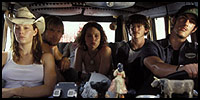 "The Texas Chainsaw Massacre" has been advertised as a remake to the disturbing, genuinely unsettling 1974 classic of the same name, and it has been called a "reimagining" from first-time feature director Marcus Nispel and producer Michael Bay. Hence, it unavoidably invites a constant comparison, sometimes unwarranted, that it not once lives up to. In all of its similarities and sly homages and in all of its narrative and filmmaking differentiations, this updated version strikes a glaringly inferior note from beginning to end. Get ready for a review that will ultimately come off as more negative than positive, only because of its lofty source material. Truth be told, "The Texas Chainsaw Massacre" is no more a remake to the original than any of its sequels are; they all have stories that are reminiscent of each other, but not exactly identical. Judging the film in question as a remake—a generously loose one at that, but one advertised as such—the movie is an astounding disappointment that does at least a hundred things wrong. However, judging it on its own merits and placing it up against other recent genre films exposes it to be a pretty good, stylishly crafted slasher flick.
"The Texas Chainsaw Massacre" has been advertised as a remake to the disturbing, genuinely unsettling 1974 classic of the same name, and it has been called a "reimagining" from first-time feature director Marcus Nispel and producer Michael Bay. Hence, it unavoidably invites a constant comparison, sometimes unwarranted, that it not once lives up to. In all of its similarities and sly homages and in all of its narrative and filmmaking differentiations, this updated version strikes a glaringly inferior note from beginning to end. Get ready for a review that will ultimately come off as more negative than positive, only because of its lofty source material. Truth be told, "The Texas Chainsaw Massacre" is no more a remake to the original than any of its sequels are; they all have stories that are reminiscent of each other, but not exactly identical. Judging the film in question as a remake—a generously loose one at that, but one advertised as such—the movie is an astounding disappointment that does at least a hundred things wrong. However, judging it on its own merits and placing it up against other recent genre films exposes it to be a pretty good, stylishly crafted slasher flick.
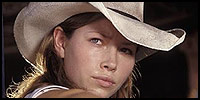 It is August 18, 1973, and five young friends—lovebirds Erin (Jessica Biel) and Kemper (Eric Balfour), horndogs Andy (Mike Vogel) and Pepper (Erica Leerhsen), and single man out Morgan (Jonathan Tucker)—are headed across the dusty backroads of Texas to a Lynyrd Skynyrd concert. When they make the wrong decision in picking up a dazed and horrified teenage girl (Lauren German) wandering along the road, they are thrust into a living nightmare involving a family of demented cannibals. Their biggest culprits: the chainsaw-wielding Leatherface (Andrew Bryniarski), who constructs faces out of human flesh, and the necrophilic Sheriff Hoyt (R. Lee Ermey), who turns out not to be the savior the ill-fated five expect.
It is August 18, 1973, and five young friends—lovebirds Erin (Jessica Biel) and Kemper (Eric Balfour), horndogs Andy (Mike Vogel) and Pepper (Erica Leerhsen), and single man out Morgan (Jonathan Tucker)—are headed across the dusty backroads of Texas to a Lynyrd Skynyrd concert. When they make the wrong decision in picking up a dazed and horrified teenage girl (Lauren German) wandering along the road, they are thrust into a living nightmare involving a family of demented cannibals. Their biggest culprits: the chainsaw-wielding Leatherface (Andrew Bryniarski), who constructs faces out of human flesh, and the necrophilic Sheriff Hoyt (R. Lee Ermey), who turns out not to be the savior the ill-fated five expect.
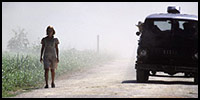 "The Texas Chainsaw Massacre" is serious about recapturing the stark feel of its 29-year-old predecessor, and admirably so. Unfortunately, it isn't always successful. As written by newcomer Scott Kosar, the story is needlessly complicated and drawn out when the simpler, to-the-point 1974 feature was tighter and more effective. Why must Erin, for example, return to the killers' lair multiple times before she realizes her life is in danger?
"The Texas Chainsaw Massacre" is serious about recapturing the stark feel of its 29-year-old predecessor, and admirably so. Unfortunately, it isn't always successful. As written by newcomer Scott Kosar, the story is needlessly complicated and drawn out when the simpler, to-the-point 1974 feature was tighter and more effective. Why must Erin, for example, return to the killers' lair multiple times before she realizes her life is in danger?
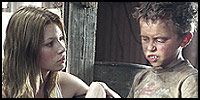 Other changes in the pace and narrative are maddening in their misguidedness. The Leatherface from decades' past was so very frightening, as was the film, because he knew exactly what his murderous mission was and wasted no time in disposing of his victims when they trespassed on his property. When they walked in his front door, he would abruptly show up and hit them over the head with a hammer, as fast as that. Here, Leatherface, and again also the film, is less threatening and unpredictable because he follows the tired tried-and-true staples of other horror villains, springing up on his victims only after they have wandered around his house for five minutes. In other words, Leatherface lacks the force and go-getter attitude he has been known for in the past, and it does nothing but hinder the film as a whole.
Other changes in the pace and narrative are maddening in their misguidedness. The Leatherface from decades' past was so very frightening, as was the film, because he knew exactly what his murderous mission was and wasted no time in disposing of his victims when they trespassed on his property. When they walked in his front door, he would abruptly show up and hit them over the head with a hammer, as fast as that. Here, Leatherface, and again also the film, is less threatening and unpredictable because he follows the tired tried-and-true staples of other horror villains, springing up on his victims only after they have wandered around his house for five minutes. In other words, Leatherface lacks the force and go-getter attitude he has been known for in the past, and it does nothing but hinder the film as a whole.
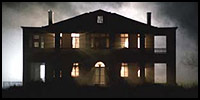 Additionally, every shot paid tribute to from the original seems to hold less weight here, with some worthlessly truncated and others mysteriously absent (where the heck is the quintessential under-the-swing dolly shot?). Certain scenes that played out in the original in startling unbroken shots are robbed of their unremitting dark power by Glen Scantlebury (2001's "Joy Ride"), whose editing is so choppy, artificial, and MTV-ish that the action onscreen is occasionally unintelligible. Try as he might, the cinematography by Daniel C. Pearl (who also did the first film) can't even begin to match the authentic grittiness and moody atmospherics of the original. The house the killers live in is more unconventional and outwardly questionable, whereas the normalcy vs. grotesquerie of the 1974 abode (not to mention the flawless production design) was infinitely scarier and more memorable. The family of cannibals is overpopulated, less plausible as cold-blooded savages, and their relationships with each other even more slight and undistinguished. The wraparound sequence of purported real-life footage of the family's home and the aftermath of their victims, while perfectly narrated by returnee John Larroquette, isn't totally necessary; the reliable black-on-white narration crawl would have been more welcome and less blatantly derivative of "The Blair Witch Project." And, finally, a climactic plot point involving a stolen baby is a truly worthless and cornball addition that should have been discarded at the pre-production stage.
Additionally, every shot paid tribute to from the original seems to hold less weight here, with some worthlessly truncated and others mysteriously absent (where the heck is the quintessential under-the-swing dolly shot?). Certain scenes that played out in the original in startling unbroken shots are robbed of their unremitting dark power by Glen Scantlebury (2001's "Joy Ride"), whose editing is so choppy, artificial, and MTV-ish that the action onscreen is occasionally unintelligible. Try as he might, the cinematography by Daniel C. Pearl (who also did the first film) can't even begin to match the authentic grittiness and moody atmospherics of the original. The house the killers live in is more unconventional and outwardly questionable, whereas the normalcy vs. grotesquerie of the 1974 abode (not to mention the flawless production design) was infinitely scarier and more memorable. The family of cannibals is overpopulated, less plausible as cold-blooded savages, and their relationships with each other even more slight and undistinguished. The wraparound sequence of purported real-life footage of the family's home and the aftermath of their victims, while perfectly narrated by returnee John Larroquette, isn't totally necessary; the reliable black-on-white narration crawl would have been more welcome and less blatantly derivative of "The Blair Witch Project." And, finally, a climactic plot point involving a stolen baby is a truly worthless and cornball addition that should have been discarded at the pre-production stage.
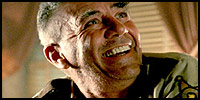 Wow. So I hated it, right? Not quite. For all of its missteps, great and small, the film is crafted with respect and tension, and the horror is more palpably felt than the norm thanks to some first-rate performances. Usually in the horror genre, victims and heroines scream and run, but you can always tell that they are acting and their lives are not really in danger. As the strong-willed but terrified Erin, Jessica Biel (2002's "The Rules of Attraction") is exceptional in what could only have been an emotionally and physically exhaustive experience. Biel screams, bawls her eyes out, shakes, sprints from killers, and faces some pretty serious moral dilemmas, and she does it all with such a rare intensity that you can't help but be convinced and involved in her plight. The other actors, none more so than a standout Jonathan Tucker (1999's "The Virgin Suicides"), follow Biel's lead with realistic aplomb.
Wow. So I hated it, right? Not quite. For all of its missteps, great and small, the film is crafted with respect and tension, and the horror is more palpably felt than the norm thanks to some first-rate performances. Usually in the horror genre, victims and heroines scream and run, but you can always tell that they are acting and their lives are not really in danger. As the strong-willed but terrified Erin, Jessica Biel (2002's "The Rules of Attraction") is exceptional in what could only have been an emotionally and physically exhaustive experience. Biel screams, bawls her eyes out, shakes, sprints from killers, and faces some pretty serious moral dilemmas, and she does it all with such a rare intensity that you can't help but be convinced and involved in her plight. The other actors, none more so than a standout Jonathan Tucker (1999's "The Virgin Suicides"), follow Biel's lead with realistic aplomb.
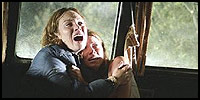 Likewise, director Marcus Nispel and screenwriter Scott Kosar have come up with a handful of imaginative plot delineations that actually do work, including the face of a major character that Leatherface skins and wears in a key scene, and a climactic chase through a real-life slaughterhouse. In fact, the final thirty minutes are easily its most suspenseful and positively cringe-worthy section, as Biel's Erin is chased and chased and chased some more by Leatherface, in what has to be one of the longest cinematic on-foot chase scenes in history. It's actually quite impressive. Getting there, ultimately, takes way too long and gets tangled in too many extraneous subplots.
Likewise, director Marcus Nispel and screenwriter Scott Kosar have come up with a handful of imaginative plot delineations that actually do work, including the face of a major character that Leatherface skins and wears in a key scene, and a climactic chase through a real-life slaughterhouse. In fact, the final thirty minutes are easily its most suspenseful and positively cringe-worthy section, as Biel's Erin is chased and chased and chased some more by Leatherface, in what has to be one of the longest cinematic on-foot chase scenes in history. It's actually quite impressive. Getting there, ultimately, takes way too long and gets tangled in too many extraneous subplots.
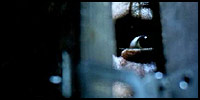 1974's "The Texas Chainsaw Massacre," directed by Tobe Hooper, was a ghastly, unshakable, one-of-a-kind motion picture, made with few resources but a lot of dedication and filmmaking artistry. It has not in any way been threatened by 2003's "The Texas Chainsaw Massacre," which is sporadically intense rather than outright scary, thoroughly conventional in its horror movie cliches, and more predictable than it would like to be. Even as far as this year's '70s-style horror flicks go, it isn't the best—both "House of 1000 Corpses" and "Wrong Turn" are superior in frights, originality, and accuracy to the time period. Ardent fans of the original "The Texas Chainsaw Massacre" will not be happy with what they see in this bigger-budgeted, glossier update. Direcor Tobe Hooper captured luck in a bottle some 29 years ago, and it has not be masterfully replicated here. If they can do away with their deep-fermented memories and view this one as a stand-alone feature, however, what they will find may surprise them: a notably more inspired genre effort than first meets the eye.
1974's "The Texas Chainsaw Massacre," directed by Tobe Hooper, was a ghastly, unshakable, one-of-a-kind motion picture, made with few resources but a lot of dedication and filmmaking artistry. It has not in any way been threatened by 2003's "The Texas Chainsaw Massacre," which is sporadically intense rather than outright scary, thoroughly conventional in its horror movie cliches, and more predictable than it would like to be. Even as far as this year's '70s-style horror flicks go, it isn't the best—both "House of 1000 Corpses" and "Wrong Turn" are superior in frights, originality, and accuracy to the time period. Ardent fans of the original "The Texas Chainsaw Massacre" will not be happy with what they see in this bigger-budgeted, glossier update. Direcor Tobe Hooper captured luck in a bottle some 29 years ago, and it has not be masterfully replicated here. If they can do away with their deep-fermented memories and view this one as a stand-alone feature, however, what they will find may surprise them: a notably more inspired genre effort than first meets the eye.
|
© 2003 by Dustin Putman |














